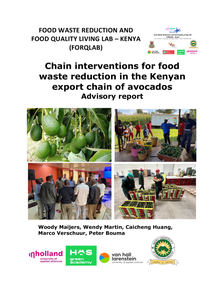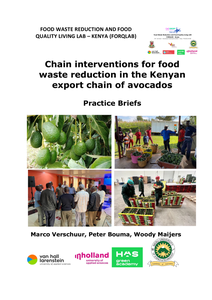Active sachets can be used to manage postharvest losses associated with phytopathogens in fruit and vegetables. Diseases associated with phytopathogens are the principal causes of avocado losses postharvest. This study was performed to develop antifungal active sachet-based oregano oil microencapsulated with starch/agave fructans that allows in vivo and in vitro control of phytopathogens associated with avocado decay. In addition, avocado-sachet interactions were studied. Oregano oil sachets inhibited 100% of the in vitro growth of Colletotrichum gloeosporioides, Colletotrichum acutatum, Diaporthe passiflorae, and Neoscytalidium hyalinum at 30 °C for 12 d The efficacy of the oregano oil sachets was confirmed on avocados inoculated with C. gloeosporioides. Active sachets reduced the injury area of anthracnose infection in avocado without negative effects on the color or firmness of the fruit, compared to untreated control. Treatment also caused significantly higher (p < 0.05) phenylalanine ammonia-lyase, chitinase, β-1,3-glucanase, catalase and peroxidase activities compared to the control fruit. In addition, antifungal sachets significantly enhanced the contents of total flavonoids and phenolic compounds in treated avocados.
DOCUMENT
Active antifungal packaging is a technological solution for reducing the postharvest losses of fruits and vegetables associated with phytopathogens. Anthracnose (Colletotrichum gloeosporioides) is the principal fungus that causes post-harvest avocado fruit decay. In this study, antifungal sachets filled with oregano oil-starch capsules were prepared, and their active effects were demonstrated on Hass avocado fruits. Oregano oil (31 % of carvacrol) was encapsulated with corn starch by spray drying. Tyvek sachets (4 × 4 cm) filled with 80 (T1) and 160 mg (T2) of oregano oil-starch capsules (99.35 ± 1.86 mg g − 1) were fabricated. The antifungal effects of the sachets were tested in vitro and in vivo using a humidity chamber (90–95 % relative humidity (RH)) on fruits inoculated with anthracnose. The results showed that T1 and T2 inhibited 75.21 ± 2.81 and 100 % in vitro growth of anthracnose at 25 °C for 12 days. Furthermore, Hass avocado fruits stored in a humidity chamber at 25 °C for 6 days showed that only T2 significantly (p < 0.05) reduced the area of lesion produced by artificial inoculation of Hass avocado fruits with anthracnose. On average, the lesion area in the Hass avocado fruits treated with T2 was 13.94 % smaller than that in the control fruit.
MULTIFILE
This publication the avocado advisory report which is based on popular papers (practice briefs) of master and bachelor theses and business assignments of students at three Dutch Universities of Applied Sciences: Van Hall Larenstein (VHL), InHolland and HAS Green Academy, and Meru University of Science and Technology in Kenya. All 23 theses and business assignments were commissioned through the research project entitled “Food Waste Reduction and Food Quality LivingLab (FORQLAB)” in Kenya.
DOCUMENT

With this project we strived to contribute to structural reduction of post-harvest food losses and food quality improvement in the Kenyan avocado and dairy value chains through the application of technical solutions and tools as well as improved coordination in those food chains. The consortium had four types of partners: 1. Universities (2 Kenyan, 4 Dutch), 2. Private sector actorsin those chains, 3. Organisations supporting those chains, and 4. Network partners. The applied research has been implemented in cooperation with all partners, whereby students at involved universities conducted most of the field studies and all other consortium partners support and interact depending on the phases.The FORQLAB project targeted two areas in Kenya for both commodities, a relatively well-developed chain in the central highlands and a less-develop chain in Western-Kenya. The research methods were the business to business and multi-stakeholder (living lab) approaches to increase the potential for uptake of successful interventions in the chain. The project consisted of four phases: 1. Inventory and inception, 2. Applied research, 3. Spreading research outputs through living lab networks, 4. Translation of project output in curricula and trainings. The outcomes were: two knowledge exchange platforms (Living Labs) supported with some advice for sustainable food loss reduction, a research agenda, proposals for ICT and other tech solutions and an implementation strategy; communication and teaching materials for universities and TVETs; and knowledge transfer and uptake.
DOCUMENT

This booklet presents the practice briefs (popular papers) of master and bachelor theses and business assignments of students at three Dutch Universities of Applied Sciences: Van Hall Larenstein (VHL), InHolland and HAS Green Academy, and Meru University of Science and Technology in Kenya. All theses and business assignments were commissioned through the researchproject entitled “Food Waste Reduction and Food Quality Living Lab (FORQLAB)” in Kenya.
DOCUMENT

From the publisher: "Background: The introduction of whole new foods in a population may lead to sensitization and food allergy. This constitutes a potential public health problem and a challenge to risk assessors and managers as the existing understanding of the pathophysiological processes and the currently available biological tools for prediction of the risk for food allergy development and the severity of the reaction are not sufficient. There is a substantial body of in vivo and in vitro data describing molecular and cellular events potentially involved in food sensitization. However, these events have not been organized in a sequence of related events that is plausible to result in sensitization, and useful to challenge current hypotheses. The aim of this manuscript was to collect and structure the current mechanistic understanding of sensitization induction to food proteins by applying the concept of adverse outcome pathway (AOP). Main body: The proposed AOP for food sensitization is based on information on molecular and cellular mechanisms and pathways evidenced to be involved in sensitization by food and food proteins and uses the AOPs for chemical skin sensitization and respiratory sensitization induction as templates. Available mechanistic data on protein respiratory sensitization were included to fill out gaps in the understanding of how proteins may affect cells, cell-cell interactions and tissue homeostasis. Analysis revealed several key events (KE) and biomarkers that may have potential use in testing and assessment of proteins for their sensitizing potential. Conclusion: The application of the AOP concept to structure mechanistic in vivo and in vitro knowledge has made it possible to identify a number of methods, each addressing a specific KE, that provide information about the food allergenic potential of new proteins. When applied in the context of an integrated strategy these methods may reduce, if not replace, current animal testing approaches. The proposed AOP will be shared at the www.aopwiki.org platform to expand the mechanistic data, improve the confidence in each of the proposed KE and key event relations (KERs), and allow for the identification of new, or refinement of established KE and KERs." Authors: Jolanda H. M. van BilsenEmail author, Edyta Sienkiewicz-Szłapka, Daniel Lozano-Ojalvo, Linette E. M. Willemsen, Celia M. Antunes, Elena Molina, Joost J. Smit, Barbara Wróblewska, Harry J. Wichers, Edward F. Knol, Gregory S. Ladics, Raymond H. H. Pieters, Sandra Denery-Papini, Yvonne M. Vissers, Simona L. Bavaro, Colette Larré, Kitty C. M. Verhoeckx and Erwin L. Roggen
LINK
Banana is an important commercial fruit crop for smallholder farmers in Arba Minch, southern Ethiopia. However, its sector is experiencing many constraints and limited attention given to productivity and marketing. Therefore, this study was conducted to analyze the banana value chain in order to identify constraints on productivity and marketing, and possibilities of improvements towards a sustainable value chain in Arba Minch. Data were collected through a survey, key informants’ interviews, and focus group discussions. Different analytical and statistical tools were used for data analysis. Results describe actors, supporters, and influencers of the existing banana chain. The current banana chain has three different distribution channels in Arba Minch. The channel that connects with rural consumers has the highest value share for farmers while the channel that includes traveling traders has the lowest value share for farmers. The marketing cooperative channel has an intermediate value share for farmers in the chain. Poor agronomic practice, diseases, pests, and climate change were the major constraints for the banana yield while limited market information, lack of cold store and refrigerated trucks, poor post-harvest handling, lack of alternative markets, and weak capacity of cooperatives were the main constraints for banana marketing in Arba Minch. Economic, social and environmental indicators have a moderate sustainability performance within the Ethiopian context. The chain has an advantage in terms of profitability, employment, emission of air pollutants and constraints in terms of coordination, value share, profit margin, market diversity, product and market information, transportation, waste management, and safety and hygiene.
DOCUMENT

The consortium would like to contribute to structural reduction of post-harvest and food losses and food quality improvement in Kenyan avocado and dairy value chains via the application of technical solutions and tools as well as improved chain governance competences in those food chains. The consortium has four types of partners: 1. Universities (2 Kenyan, 4 Dutch), 2. Private sector actors in those chains, 3. Organisations supporting those chains, and 4. Associate partners which support category 1 to 3 partners through co-financing, advice and reflection. The FORQLAB project targets two areas in Kenya for both commodities, a relatively well-developed chain in the central highlands and a less-develop chain in Western-Kenya. The approach is business to business and the selected regions have great potential for uptake of successful chain innovations as outcome of research results. The results are scalable for other fresh and processed product chains via a living lab network approach. The project consists of 5 work packages (WPs): 1. Inventory , status quo and inception, 2. Applied research, 3. Dissemination of research outputs through living lab networks, 4. Translation of project output in curricula and trainings, and 5. Communication among partners and WPs. The applied research will be implemented in cooperation with all partners, whereby students of the consortium universities will conduct most of the field studies and all other partners support and interact depending on the WPs. The expected outcomes are: two knowledge exchange platforms (Living Labs) supported with hands on sustainable food waste reduction implementation plans (agenda strategy); overview and proposals for ready ICT and other tech solutions; communication and teaching materials for universities and TVETs; action perspectives; and knowledge transfer and uptake.
How do we increase biodiversity in the Netherlands? By working together! What can food forests and restaurants mean for each other? This report focuses on the question: “What is the potential of collaborations between food forests and restaurants in the Netherlands?”Interviews revealed that successful partnerships are based on direct supplier relationships, internal motivation and niche products that create a unique selling point.
DOCUMENT
